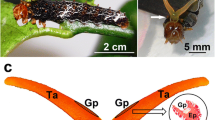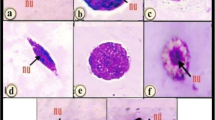Summary
In pupae ofGalleria mellonella L.,Pieris brassicae L. andLymantria monacha L. the encapsulation of injected pieces of nylon thread is checked, if the threads are provided with a cover of secretions. As the combination of the three secretions effects a stronger checking than each of them, a cooperative mechanism of the checking system is assumed. ConcerningLymantria dispar L. the gland secretions did not reduce the encapsulation. Beside an obvious dependence of the effect of the secretions on dose, sensitiveness of the hemocytes which are involved in encapsulation, towards the particular secretions, plays an important role as well. This sensitiveness seems to be proper to host species and concerning some of them it can even be modified by the influence of temperature.
This checking effect of the secretions is based on the inhibition of the typical hemocyte reaction, i.e., the development of cytoplasmatic pseudopodia with which hemocytes stick to the surface of a foreign body within the body cavity of the insect in order to form a capsule. On the hemocytes ofGilpinia hercyniae Htg. (Hym., Diprionidae) none of these secretions exerts a checking effect.
This gives reason for the assumption that the secretory checking system of femalePimpla turionellae is specific for lepidopterous hosts. Chemical mechanisms, which might be involved in the blocking effect, are also discussed.
Zusammenfassung
In den Puppen einiger Lepidopterenarten wird die hämocytäre Einkapselung implantierter Nylonfadenstücke durch die Sekrete der drei Genitalanhangsdrüsen desPimpla-Weibchens gehemmt. Der Grad der von den einzeln oder kombiniert angebrachten Sekreten induzierten Wirkung ist teils dosisabhängig, teils wird er durch wirtsartspezifische Eigentümlichkeiten modifiziert. In den relativ großen Puppen vonL. dispar war kein Hemmeffekt festzustellen.
Die Hemmung beruht auf der Blockierung der Bildung pseudopodialer Cytoplasmafortsätze bei jenen Hämocytentypen, die aufgrund dieser Fähigkeit an der Einkapselung hauptsächlich beteiligt sind. Diese Sensitivität der Hämocyten gegenüber den Drüsensekreten fehlt bei der HymenoptereGilpinia; bei den untersuchtenLymantria-Arten hängt sie teilweise von der thermischen Vorbehandlung der Puppen ab. Chemische Wirkungsmechanismen, die diesem Blockierungseffekt zugrunde liegen könnten, werden diskutiert.
Similar content being viewed by others
Literatur
Balazs, E.A., Szirmai, J.A.: Quantitative determination of cationic dyebinding in connective tissue. J. Histochem.6, 278–289 (1958)
Brewer, F.D., Vinson, S.B.: Chemicals affecting the encapsulation of foreign material in an insect. J. Invertebr. Pathol.18, 287–289 (1971)
Briggs, J.D.: Immunological responses. In: The physiology of insecta. Vol. III, pp. 259–283. M. Rockstein, ed. New York, London: Academic Press 1964
Carrington, C.B., Tenney, S.M.: Chemical constituents of Haemolymph and Tissue inTelea polyphemus Cram. with particular reference to the question of ion binding. J. Insect Physiol.3, 402–413 (1959)
Doutt, R.L.: In: Insect pathology: An advanced treatise, E.A. Steinhaus, ed., Vol. 2, pp. 393–422, New York: Academic Press 1963
Farber, S.J., Schubert, M., Schuster, N.: The binding of cations by chondroitin sulfate. J. Clin. Invest.36, 1715–1722 (1957)
Führer, E.: Sekretion von Mucopolysacchariden im weiblichen Geschlechtsapparat vonPimpla turionellae L. (Hym., Ichneumonidae). Z. Parasitenkd41, 207–213 (1973)
Hall, J.E., Weaver, J.E., Gomez-Miranda, B.: Histopathology of Lecithodendriid Trematode Infections in Stonefly Naiads. J. Invertebr. Pathol.13, 91–113 (1969)
Haydack, M.H.: A food for rearing laboratory insects. J. Econ. Entomol.29, 1026 (1936)
Kilincer, N.: Untersuchungen über die hämocytäre Abwehrreaktion der Puppe vonGalleria mellonella L. (Lep.) und über ihre Hemmung durch den PuppenparasitenPimpla turionellae L. (Hym. Ichneumonidae). Z. Angew. Entomol.78, 340–370 (1975)
Kitano, H.: Experimental studies on the parasitism ofApanteles glomeratus L. with special reference to its encapsulation inhibiting capacity. Bull. Tokyo Gekugei Univ. (IV)21, 95–136 (1969)
Loughton, B.G.: The effect of parasitation byPimpla turionellae L. on the emergence from the pupal case of its host,Galleria mellonella L. Can. Entomol.97, 314–316 (1965)
Nappi, J., Streams, F.A.: Haemocytic reactions ofDrosophila melanogaster to the parasitesPseudocoila mellipes andP. bochei. J. Insect Physiol.15, 1551–1566 (1969)
Neumann, W., Habermann, E.: Paper electrophoresis separation of pharmacologically and biochemically active components of bee and snake venoms. In: Venoms, E.B. Eleanor and N. Porges, eds., Publication No. 44, Washington, D.C.: American Association for the Advancement of Science 1956
Osman, S.E.: Parasitentoleranz von Schmetterlingspuppen. Maskierung der Parasiteneier mit Mucopolysacchariden. Die Naturwissenschaften61, 453–454 (1974)
Osman, S.E.: Über die Bedeutung der im weiblichen Geschlechtsapparat vonPimpla turionellae L. (Hym., Ichneumonidae) produzierten Drüsensekrete für die Parasitentoleranz der Wirtspuppen. Diss. Forst. Fak. Univ. Göttingen (1977)
Puttler, B., van den Bosch, R.: Partial immunity ofLaphygma exigua (Hübner) to the parasite,Hyposoter exigua (Viereck). J. Econ. Entomol.52, 327–329 (1959)
Reik, L.: Contacts between insect blood cells, with special reference to the structure of the capsule formed about parasites. M. Sc. Dissertation, Univ. Cambridge (1968)
Rizki, M.T.M.: The larval blood cells ofDrosophila willistoni. J. Exp. Zool.123, 397–411 (1953)
Rotheram, S.M.: Immune surface of eggs of a parasite insect. Nature (Lond.)214, 700 (1967)
Salt, G.: The ichneumonid parasiteNemeritis canescens (Grav.) in relation to the wax mothGalleria mellonella (L.) Trans. R. Entomol. Soc. London116, 1–14 (1964)
Salt, G.: The cellular defence reactions of insects. 118 p. Cambridge: Cambridge Univ. Press 1970
Schneider, G.: Die Abwehrreaktion des Insektenblutes und ihre Beeinflussung durch die Parasiten. Vierteljahresschr. Naturforsch. Ges. Zürich95, 22–44 (1950)
Streams, F.A.: Factors affecting the susceptibility ofPseudocoila bochei eggs to encapsulation byDrosophila melanogaster. J. Invertebr. Pathol.12, 379–387 (1968)
Streams, F.A., Greenberg, L.H.: Inhibition of the defence reaction ofDrosophila melanogaster parasitized simultaneously by the waspsPseudocoila bochei andP. mellipes. J. Invertebr. Pathol.13, 371–377 (1969)
Timberlake, P.H.: Experimental parasitism. A study of the biology ofLimnerium validum (Cresson). U.S. Dept. Agric. Bur. Entomol. Bull. Techn. ser.19, pt 5: 71–92 (1912)
Thompson, W.R.: A catalogue of the parasites and predators of insect pests, sec. 2, part 4. The Commonwealth institute of biol. control, Ottawa, Ont., Canada (1957)
Toole, B.P.: Hyaluronate and Hyaluronidase in morphogenesis and differentiation. Am. Zool.13, 1061–1065 (1973)
Winson, S.B.: Defence reaction and hemocytic changes inHeliothis virescens in response to its habitual parasitoidCardiochiles nigriceps. J. Invertebr. Pathol.18, 94–100 (1971)
Walters, D.R., Williams, C.M.: Reaggregation of insect cells as studied by a new method of tissue and organ culture. Science154, 516–517 (1966)
Willers, D.: Untersuchungen über die physiologische Eignung verschiedener Schmetterlingspuppen als Wirte für den PuppenparasitenPimpla turionellae L. Diplomarbeit Forst. Fak. Univ. Göttingen, 45 pp (1974)
Author information
Authors and Affiliations
Additional information
Gefördert durch die Deutsche Forschungsgemeinschaft
Rights and permissions
About this article
Cite this article
Osman, S.E. Die Wirkung der Sekrete der weiblichen Genitalanhangsdrüsen vonPimpla turionellae L. (Hym., Ichneumonidae) auf die Hämocyten und die Einkapselungsreaktion von Wirtspuppen. Z. Parasitenkd. 57, 89–100 (1978). https://doi.org/10.1007/BF00927631
Received:
Issue Date:
DOI: https://doi.org/10.1007/BF00927631




